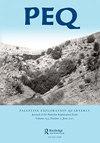Masada: From Jewish Revolt to Modern Myth
IF 0.8
2区 历史学
0 ARCHAEOLOGY
引用次数: 0
Abstract
investments and construction efforts by the Hasmonean rulers and King Herod in Jericho, Masada, Machaerus and Callirrhoe. Finally, in the Byzantine era, the religious significance of the region grew and dozens of monasteries were built in its vicinity. Itamar Taxel’s detailed and nuanced discussion of the Byzantine–Early Islamic transition is particularly illuminating (although he does not have much to say about the possible impact of a shift in climate). Frank H. Neumann and Wolfgang Zwickel as well as Eva Kaptijn provide useful maps that help the reader trace the rising and falling number of settlements near the lake at various points in time. The volume’s chapters vary in length and depth. Alongside thematic chapters on water management, agrarian resources, textiles and references to the Dead Sea in the Bible there are important contributions on specific sites, including some by archaeologists who have been excavating in the area for several years: Gideon Hadas on Ein Gedi, Lorenzo Nigro on Jericho, Konstantinos D. Politis on Ghor es-Safi and Győző Vörös on Machaerus. Inevitably, there are a number of shortcomings as well. While informative and insightful, the introductory essay by Martin Peilstöcker and Sabine Wolfram is dedicated to the exhibition at Chemnitz rather than outlining and framing the content of the volume. Contributors were clearly tasked with approaching the subject matter from different perspectives, but there is a degree of overlap between the essays. The order of the chapters could have been more systematic. For instance, it would have been better to cluster together Katharina Galor’s essay on gender at Qumran, Marcello Fidanzio’s contribution on Qumran cave 11Q and Jean-Baptiste Humbert’s interesting hypothesis about a Hasmonean ‘axis’ that connected Jerusalem, Hyrcanion, Qumran, Callirrhoe andMachaerus (in the volume these are separated by several other chapters). Finally, with many of the essays written by archaeologists, the volume privileges sedentary material culture. Less archaeologically visible nomadic groups such as the Late Bronze Age ‘Shasu’ or the saraceni of the late Roman and early Byzantine era are mentioned only briefly. Setting these issues aside, this volume marks a very important contribution to our understanding of the history of life at the Dead Sea. Supported by several maps, images and illustrations, it presents an up-to-date picture of the interdisciplinary study of this region’s past.Masada:从犹太起义到现代神话
哈斯莫内统治者和希律王在杰里科、马萨达、马查鲁斯和卡利里霍的投资和建设工作。最后,在拜占庭时代,该地区的宗教意义越来越大,附近建造了数十座修道院。Itamar Taxel对拜占庭-早期伊斯兰过渡的详细而细致的讨论特别有启发性(尽管他对气候变化的可能影响没有太多要说的)。Frank H.Neumann和Wolfgang Zwickel以及Eva Kaptijn提供了有用的地图,帮助读者追踪不同时间点湖泊附近定居点数量的上升和下降。该卷各章的篇幅和深度各不相同。除了关于水资源管理、农业资源、纺织品和《圣经》中提及死海的主题章节外,还对特定遗址做出了重要贡献,其中包括在该地区挖掘了几年的考古学家的一些贡献:埃因盖迪的吉迪恩·哈达斯、杰里科的洛伦佐·尼格罗、古尔萨菲的康斯坦丁诺斯·波利蒂斯和马查鲁斯的吉兹·沃罗斯。不可避免地,也存在许多缺点。马丁·佩尔斯托克(Martin Peilstöcker)和萨宾·沃尔夫拉姆(Sabine Wolfram。投稿人的任务显然是从不同的角度处理主题,但文章之间有一定程度的重叠。章节的顺序本可以更系统。例如,最好将Katharina Galor关于库姆兰性别的文章、Marcelo Fidanzio对库姆兰洞穴11Q的贡献以及Jean-Baptiste Humbert关于连接耶路撒冷、Hyrcanion、库姆兰、Callirhoe和Machaerus的Hasmonean“轴心”的有趣假设集中在一起(在该卷中,这些被其他几章分开)。最后,与考古学家写的许多文章一样,这本书赋予了久坐的物质文化特权。考古上不太明显的游牧群体,如青铜时代晚期的“沙苏”或罗马晚期和拜占庭早期的萨拉塞尼人,只被简要提及。抛开这些问题不谈,这本书对我们理解死海生命史做出了非常重要的贡献。在几张地图、图像和插图的支持下,它展示了该地区过去跨学科研究的最新情况。
本文章由计算机程序翻译,如有差异,请以英文原文为准。
求助全文
约1分钟内获得全文
求助全文

 求助内容:
求助内容: 应助结果提醒方式:
应助结果提醒方式:


